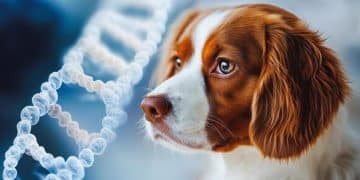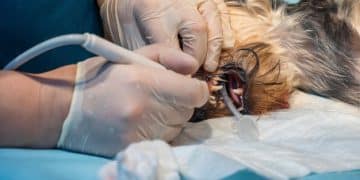Dog Bloat: Is Your Breed at Risk? Signs & Prevention Tips
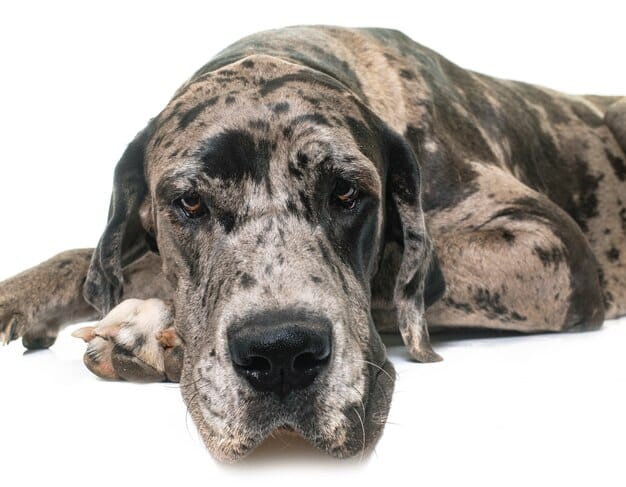
Bloat, or gastric dilatation-volvulus (GDV), is a life-threatening condition in dogs where the stomach fills with gas and twists. Certain breeds are more prone to bloat due to their deep chests and genetic predispositions. Early recognition of warning signs and implementing preventive strategies are crucial for safeguarding your dog’s health.
Is your furry friend pacing restlessly, drooling excessively, or showing a distended abdomen? These could be warning signs of **Is Your Dog’s Breed Prone to Bloat? Learn the Warning Signs and Prevention Strategies** a serious condition that demands immediate attention.
What is Bloat (GDV) in Dogs? Understanding the Basics
Bloat, technically known as gastric dilatation-volvulus (GDV), is a critical condition affecting dogs. It occurs when the stomach fills with gas and/or fluid, causing it to expand. This expansion can lead to a twist in the stomach, cutting off blood supply and leading to severe complications.
Understanding the mechanics and implications of GDV is essential for any dog owner, especially those with breeds predisposed to this condition.
The Mechanics of GDV
The process of GDV involves several key stages. Initially, the stomach begins to swell due to a buildup of gas, fluid, or food. Several factors can contribute to this, including rapid eating, excessive drinking, or strenuous activity after meals.
Once the stomach is distended, it becomes more susceptible to twisting. This twisting, or volvulus, is what makes GDV so dangerous.
Why is GDV a Life-Threatening Condition?
GDV is considered life-threatening for several reasons. The twisting of the stomach cuts off blood supply to the stomach itself and other vital organs. Additionally, the distended stomach can press against the diaphragm, making it difficult for the dog to breathe.
- Compromised blood flow leads to tissue damage and organ failure.
- Difficulty in breathing can result in oxygen deprivation.
- The condition often leads to shock, which can be fatal if not treated promptly.
GDV is a medical emergency and requires immediate veterinary intervention.
In summary, understanding the basics of bloat helps owners recognize the risks and take proactive measures to protect their pets. Knowing what GDV is, how it happens, and why it’s dangerous sets the foundation for early detection and prevention.
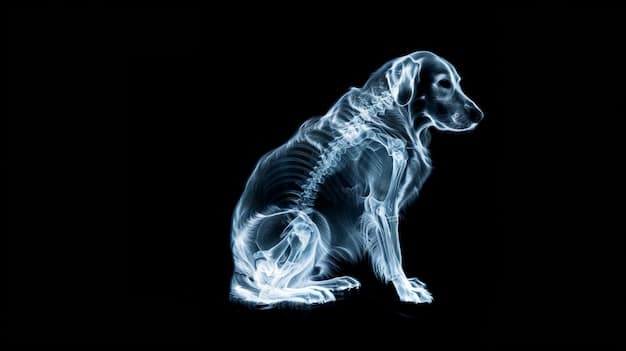
Which Dog Breeds Are Most Prone to Bloat? Identifying High-Risk Dogs
Certain dog breeds have a higher predisposition to bloat, primarily due to their deep-chested conformation. Understanding which breeds are at greater risk can help owners be more vigilant about preventive measures and recognize early warning signs.
Large and giant breeds with narrow and deep chests are particularly susceptible to GDV because their stomach has more room to move and twist.
Top Breeds at Risk
Here are some of the breeds most commonly affected by bloat:
- Great Danes: Known for their significant size and deep chests, Great Danes are among the most at-risk breeds.
- German Shepherds: A popular breed, German Shepherds also have a higher incidence of bloat due to their body structure.
- Saint Bernards: These gentle giants are prone to bloat because of their large size and deep chests.
- Weimaraners: A sporting breed with a deep chest, Weimaraners are also at increased risk.
- Irish Setters: Another breed with a deep chest, Irish Setters are susceptible to GDV.
Factors Contributing to Breed Predisposition
Several factors contribute to why certain breeds are more prone to bloat:
- Chest Conformation: Deep and narrow chests provide more room for the stomach to move and twist.
- Genetics: Some breeds may have genetic predispositions that affect the stomach’s ability to function properly.
- Eating Habits: Rapid eating and drinking, common in larger breeds, can increase the risk of bloat.
By identifying high-risk dogs, owners can take extra precautions to mitigate the risks associated with GDV, ensuring a healthier and safer life for their beloved pets.
Recognizing the Warning Signs of Bloat: What to Look For
Early detection of bloat is crucial for successful treatment. Recognizing the warning signs can make the difference between life and death for your dog. Knowing what to look for enables prompt action and veterinary intervention.
Bloat symptoms can develop rapidly, so it’s essential to be vigilant and observant, especially if you own a high-risk breed.
Key Symptoms to Watch Out For
Here are some of the most common warning signs of bloat:
- Restlessness and Pacing: A dog experiencing bloat may appear anxious and unable to settle down.
- Excessive Drooling: Increased salivation can be an early indicator of discomfort and nausea.
- Distended Abdomen: A swollen or bloated belly is a classic sign of GDV. The abdomen may feel tight to the touch.
- Unproductive Vomiting: The dog may try to vomit or regurgitate but is unable to bring anything up.
- Weakness and Collapse: As the condition progresses, the dog may become weak and eventually collapse.
Subtle Signs That Shouldn’t Be Ignored
Besides the obvious symptoms, there are some subtle signs that should not be ignored:
- Whining and Groaning: The dog may exhibit signs of pain and discomfort.
- Changes in Breathing: Rapid or shallow breathing can indicate distress and reduced oxygen levels.
- Pale Gums: Pale gums can be a sign of shock and poor circulation.
If you observe any of these symptoms, it is imperative to seek immediate veterinary care. Time is of the essence when it comes to treating bloat.
In conclusion, recognizing the warning signs of bloat is vital for ensuring your dog receives prompt and effective treatment. Being attentive to both obvious and subtle symptoms can significantly improve the chances of a positive outcome.
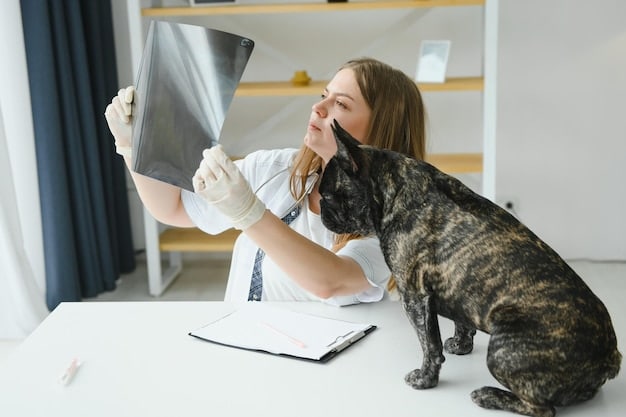
Immediate Actions if You Suspect Bloat: What to Do in an Emergency
Suspecting bloat in your dog is a frightening experience, but knowing how to respond can save their life. Immediate action is critical to stabilize your dog and get them the medical attention they need.
Your response in the first few minutes can dramatically impact the outcome. Remain calm and act swiftly.
Steps to Take Immediately
Here are the essential steps to take if you suspect your dog has bloat:
- Stay Calm: Your dog can sense your stress, so staying calm will help keep them calm as well.
- Contact Your Veterinarian: Call your veterinarian immediately and inform them that you suspect your dog has bloat. Let them know you are on your way.
- Transport Your Dog Safely: Gently transport your dog to the veterinary clinic. Avoid any unnecessary movements that could exacerbate the condition.
What to Expect at the Veterinary Clinic
At the veterinary clinic, the team will take immediate steps to diagnose and treat the bloat:
- Diagnosis: The veterinarian will perform a physical examination and may take X-rays to confirm the diagnosis of GDV.
- Decompression: The vet will attempt to decompress the stomach, often by inserting a tube through the mouth into the stomach or by using a needle to relieve gas pressure.
- Stabilization: The dog will be stabilized with IV fluids and medications to address shock and electrolyte imbalances.
- Surgery: In most cases, surgery is necessary to untwist the stomach and perform a gastropexy, which secures the stomach to the abdominal wall to prevent future twisting.
After surgery, your dog will require intensive monitoring and supportive care. The recovery process can be long, but with proper care, many dogs can make a full recovery.
In summary, taking swift and decisive action when you suspect bloat is essential for giving your dog the best chance of survival. Knowing the immediate steps to take and what to expect at the vet clinic can help you navigate this frightening emergency.
Preventative Strategies: Reducing the Risk of Bloat in Dogs
While some risk factors for bloat are unavoidable, there are several preventative strategies you can implement to reduce your dog’s chances of developing this life-threatening condition. Diet, feeding practices, and lifestyle adjustments all play a role.
Implementing preventative measures is particularly important for high-risk breeds. Small changes can make a big difference.
Diet and Feeding Practices
The following dietary adjustments can help reduce the risk of bloat:
- Feed Multiple Small Meals: Instead of one large meal, divide your dog’s daily food into two or three smaller portions. This reduces the amount of food in the stomach at any one time.
- Avoid Rapid Eating: Use slow-feed bowls or puzzle feeders to slow down your dog’s eating. This can help prevent them from gulping air while eating.
- Elevated Food Bowls: While once recommended, recent studies suggest that elevated food bowls may increase the risk of bloat in some breeds. Consult your vet for personalized advice.
- Avoid Dry Food with Oil or Fat as Top Ingredients: These ingredients can delay gastric emptying, increasing the risk of bloat.
Lifestyle Adjustments
Making certain lifestyle changes can also help prevent bloat:
- Limit Exercise Before and After Meals: Avoid strenuous exercise for at least one hour before and two hours after feeding.
- Reduce Stress: Minimize stressful situations for your dog, as stress can contribute to digestive upset and bloat.
- Provide Fresh Water: Always ensure your dog has access to fresh water, but avoid letting them drink excessive amounts at one time, especially after eating.
Considering a Prophylactic Gastropexy
For high-risk breeds, a prophylactic gastropexy might be considered. This surgical procedure attaches the stomach to the abdominal wall, preventing it from twisting.
Consult with your veterinarian to determine if a gastropexy is the right choice for your dog, weighing the benefits and risks carefully.
In summary, implementing preventative strategies is crucial for reducing the risk of bloat in dogs, especially those predisposed to the condition. By making adjustments to diet, feeding practices, and lifestyle, you can significantly improve your dog’s health and well-being.
Long-Term Care and Monitoring After a Bloat Episode
Even after successful treatment for bloat, long-term care and monitoring are essential to ensure your dog’s continued health and prevent recurrence. The recovery process requires attention to detail and close communication with your veterinarian.
Post-operative care is critical for a smooth recovery. Your vet will provide specific instructions tailored to your dog’s needs.
Post-Operative Care
Here are some key aspects of post-operative care following a bloat episode:
- Medication: Administer all medications as prescribed by your veterinarian, including pain relievers and antibiotics.
- Diet: Follow your vet’s recommendations for a special diet. This typically involves feeding small, frequent meals of easily digestible food.
- Wound Care: Keep the surgical incision clean and dry. Monitor for signs of infection, such as redness, swelling, or discharge.
- Activity Restriction: Limit your dog’s activity to prevent complications with the surgical site. Avoid strenuous exercise for several weeks.
Ongoing Monitoring
Continuous monitoring is crucial to detect any potential issues early:
- Appetite and Thirst: Monitor your dog’s appetite and water intake. Any significant changes should be reported to your veterinarian.
- Bowel Movements: Observe your dog’s bowel movements for any signs of diarrhea or constipation.
- Behavior: Watch for any changes in behavior, such as lethargy, restlessness, or signs of discomfort.
Potential Complications
Be aware of potential complications that can arise after a bloat episode:
- Infection: Surgical site infections can occur, requiring additional treatment with antibiotics.
- Arrhythmias: Heart rhythm abnormalities can develop after GDV, necessitating ongoing monitoring and medication.
- Recurrence: Although gastropexy reduces the risk, bloat can still recur. Continue to implement preventative strategies.
Consistent care and monitoring is the key to a successfully treated bloat episode.
In conclusion, long-term care and monitoring are vital components of managing bloat in dogs. By following your veterinarian’s instructions, providing attentive post-operative care, and remaining vigilant for any signs of complications, you can help your dog stay healthy and prevent future episodes.
| Key Point | Brief Description |
|---|---|
| ⚠️ Recognize GDV | Bloat (GDV) is a life-threatening condition requiring immediate vet care. |
| 🐕🦺 Breed Risk | Deep-chested breeds like Great Danes and German Shepherds are more prone. |
| 🩺 Seek Vet Help! | Restlessness, drooling, and abdominal swelling are emergency signs. |
| 🍽️ Preventative Diet | Feed small meals, use slow feeders, and limit water after eating. |
Frequently Asked Questions
▼
The survival rate for dogs with bloat varies depending on how quickly treatment is administered. With prompt veterinary intervention, including surgery, the survival rate can be around 70-80%. However, without treatment, bloat is almost always fatal.
▼
Bloat can kill a dog in a matter of hours if left untreated. The twisting of the stomach cuts off blood supply, leading to organ damage and shock. Immediate veterinary care is essential to improve the chances of survival significantly.
▼
No, bloat is not always fatal for dogs, especially if treated promptly and aggressively. Surgical intervention, including gastropexy to prevent recurrence, can significantly improve the survival rate. Early detection and swift action are key.
▼
Yes, stress can be a contributing factor to bloat in dogs. Stress can affect digestive function, potentially leading to increased gas production and stomach distention. Minimizing stress for your dog is an important preventative measure.
▼
Signs of bloat at home include restlessness, excessive drooling, a distended abdomen, unproductive vomiting, and weakness. If you notice these symptoms, contact your veterinarian immediately, as these are indicators of a serious condition.
Conclusion
In conclusion, being aware of the risks, signs, and preventative measures related to bloat is essential for dog owners, especially those with predisposed breeds. Rapid response and proactive care can significantly increase your furry friend’s chances of a healthy, happy life.

